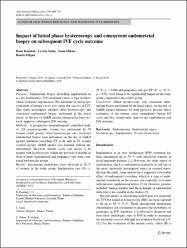| dc.contributor.author | Kumbak, Banu | |
| dc.contributor.author | Şahin, Levent | |
| dc.contributor.author | Özkan, Sema | |
| dc.contributor.author | Atılgan, Remzi | |
| dc.date.accessioned | 10.07.201910:49:13 | |
| dc.date.accessioned | 2019-07-10T19:35:38Z | |
| dc.date.available | 10.07.201910:49:14 | |
| dc.date.available | 2019-07-10T19:35:38Z | |
| dc.date.issued | 2014 | en_US |
| dc.identifier.citation | Kumbak, B., Şahin, L., Özkan, S. ve Atılgan, R. (2014). Impact of luteal phase hysteroscopy and concurrent endometrial biopsy on subsequent IVF cycle outcome. Archives of Gynecology and Obstetrics, 290(2), 369-374. https://dx.doi.org/10.1007/s00404-014-3211-y | en_US |
| dc.identifier.issn | 0932-0067 | |
| dc.identifier.uri | https://hdl.handle.net/20.500.12511/883 | |
| dc.identifier.uri | https://dx.doi.org/10.1007/s00404-014-3211-y | |
| dc.description.abstract | Purpose: Endometrial biopsy preceding implantation in in vitro fertilization (IVF) treatment causes a type of injury which facilitates implantation. Pre-treatment hysteroscopic evaluation of uterine cavity also raises the success in IVF. This study investigates whether office hysteroscopy and concurrent endometrial biopsy performed in the luteal phase, on the day of GnRH agonist initiation for long protocol, improves subsequent IVF outcome. Methods: A prospective, nonrandomized, controlled study of 128 normoresponder women was performed: In 70 women (study group), office hysteroscopy and concurrent endometrial biopsy were performed on the day of GnRH agonist initiation preceding ET cycle and in 58 women (control group), GnRH agonist was initiated without any intervention. However, uterine cavity was shown to be normal with hysteroscopy within the previous 6 months in those women. Implantation and pregnancy rates were compared between the groups. Results: Intrauterine pathologies were observed in 28 % of women in the study group. Implantation rate (38 vs. 25 %; p = 0.04) and pregnancy rate per ET (67 vs. 45 %; p = 0.01) were found to be significantly higher in the study group compared to the control group. Conclusion: Office hysteroscopy and concurrent endometrial biopsy performed in the luteal phase, on the day of GnRH agonist initiation for long protocol, provide direct evaluation of the uterine cavity immediately before ET cycle and also significantly improve the implantation and IVF outcome. | en_US |
| dc.language.iso | eng | en_US |
| dc.publisher | Springer | en_US |
| dc.rights | info:eu-repo/semantics/openAccess | en_US |
| dc.subject | Endometrial Injury | en_US |
| dc.subject | Endometrium | en_US |
| dc.subject | Hysteroscopy | en_US |
| dc.subject | Implantation | en_US |
| dc.subject | In Vitro Fertilization | en_US |
| dc.title | Impact of luteal phase hysteroscopy and concurrent endometrial biopsy on subsequent IVF cycle outcome | en_US |
| dc.type | article | en_US |
| dc.relation.ispartof | Archives of Gynecology and Obstetrics | en_US |
| dc.department | İstanbul Medipol Üniversitesi, Tıp Fakültesi, Cerrahi Tıp Bilimleri Bölümü, Kadın Hastalıkları ve Doğum Ana Bilim Dalı | en_US |
| dc.authorid | 0000-0002-3428-7359 | en_US |
| dc.identifier.volume | 290 | en_US |
| dc.identifier.issue | 2 | en_US |
| dc.identifier.startpage | 369 | en_US |
| dc.identifier.endpage | 374 | en_US |
| dc.relation.publicationcategory | Makale - Uluslararası Hakemli Dergi - Kurum Öğretim Elemanı | en_US |
| dc.identifier.doi | 10.1007/s00404-014-3211-y | en_US |
| dc.identifier.wosquality | Q3 | en_US |
| dc.identifier.scopusquality | Q2 | en_US |


















